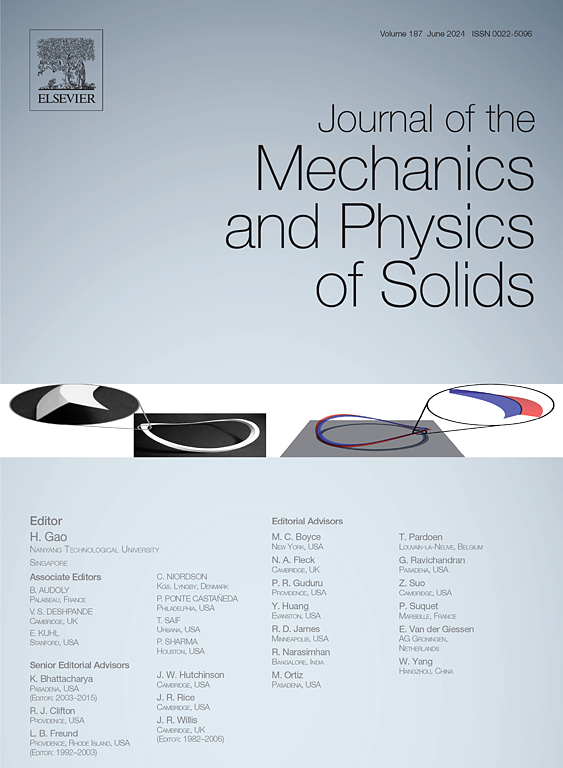高速率加载下非均质脆性介质缺陷-裂纹相互作用的各向异性损伤模型
IF 6
2区 工程技术
Q2 MATERIALS SCIENCE, MULTIDISCIPLINARY
引用次数: 0
摘要
提出了一种缺陷-裂纹相互作用的各向异性损伤模型框架,用于预测高应变率加载(应变率为102s−1 ~ 103s−1)下非均质脆性材料的单轴抗压强度。该模型能够考虑由预先存在的缺陷产生的相互作用应力场对脆性材料裂纹的影响,从而允许纳入材料微观结构。相互作用修正应力采用叠加技术计算,其中基于均匀化方法的平均应力场和基于球-谐波-展开方法的扰动应力场叠加在一起。采用滑动裂纹模型来表示裂纹在压缩条件下的扩展,计算了在相互作用应力影响下的动态翼裂扩展。通过采用张拉损伤度量的各向异性损伤模型,考虑了翼裂扩展的方向性影响。材料柔度的线性、各向异性增量考虑了相互作用对微裂纹损伤的影响。模型参数可以通过微观结构信息和/或在实验中观察到的强度、损伤和体积应变来估计。将校正后的模型用于预测工程陶瓷在不同应变率下的单轴抗压强度,实验结果吻合良好。将该模型与现有的脆性材料动态破坏细观力学模型的有效性进行了比较。本文章由计算机程序翻译,如有差异,请以英文原文为准。
An anisotropic damage model with defect–crack interactions for heterogeneous brittle media under high-rate loading
A defect–crack interaction informed anisotropic damage modeling framework is proposed to predict the uniaxial compressive strength of heterogeneous brittle materials under high-strain-rate loading (strain rates of –). The model is capable of accounting for the effect of interaction stress fields, produced by pre-existing defects, on cracks in a brittle material, allowing for the incorporation of material microstructure. The interaction-modified stresses are computed using the superposition technique where mean stress fields from a homogenization-based approach and perturbation stress fields from spherical-harmonics-expansion-based approach are superimposed. Sliding-crack model is employed to represent crack extension under compression, and dynamic wing-crack growth is computed under the influence of the interaction stresses. The directional influence of wing-crack growth is incorporated through an anisotropic damage model where a tensorial damage metric is employed. A linear, anisotropic increment in material compliance is derived accounting for the effect of interactions on micro-cracking based damage. Model parameters can be estimated from microstructural information and/or strength, damage and volumetric strain observed in experiments. The calibrated model is used to predict uniaxial compressive strength at varying strain rates of an engineering ceramic with good experimental match. We compare this model’s effectiveness with that of some existing micromechanics models for dynamic failure of brittle materials.
求助全文
通过发布文献求助,成功后即可免费获取论文全文。
去求助
来源期刊
CiteScore
9.80
自引率
9.40%
发文量
276
审稿时长
52 days
期刊介绍:
The aim of Journal of The Mechanics and Physics of Solids is to publish research of the highest quality and of lasting significance on the mechanics of solids. The scope is broad, from fundamental concepts in mechanics to the analysis of novel phenomena and applications. Solids are interpreted broadly to include both hard and soft materials as well as natural and synthetic structures. The approach can be theoretical, experimental or computational.This research activity sits within engineering science and the allied areas of applied mathematics, materials science, bio-mechanics, applied physics, and geophysics.
The Journal was founded in 1952 by Rodney Hill, who was its Editor-in-Chief until 1968. The topics of interest to the Journal evolve with developments in the subject but its basic ethos remains the same: to publish research of the highest quality relating to the mechanics of solids. Thus, emphasis is placed on the development of fundamental concepts of mechanics and novel applications of these concepts based on theoretical, experimental or computational approaches, drawing upon the various branches of engineering science and the allied areas within applied mathematics, materials science, structural engineering, applied physics, and geophysics.
The main purpose of the Journal is to foster scientific understanding of the processes of deformation and mechanical failure of all solid materials, both technological and natural, and the connections between these processes and their underlying physical mechanisms. In this sense, the content of the Journal should reflect the current state of the discipline in analysis, experimental observation, and numerical simulation. In the interest of achieving this goal, authors are encouraged to consider the significance of their contributions for the field of mechanics and the implications of their results, in addition to describing the details of their work.

 求助内容:
求助内容: 应助结果提醒方式:
应助结果提醒方式:


